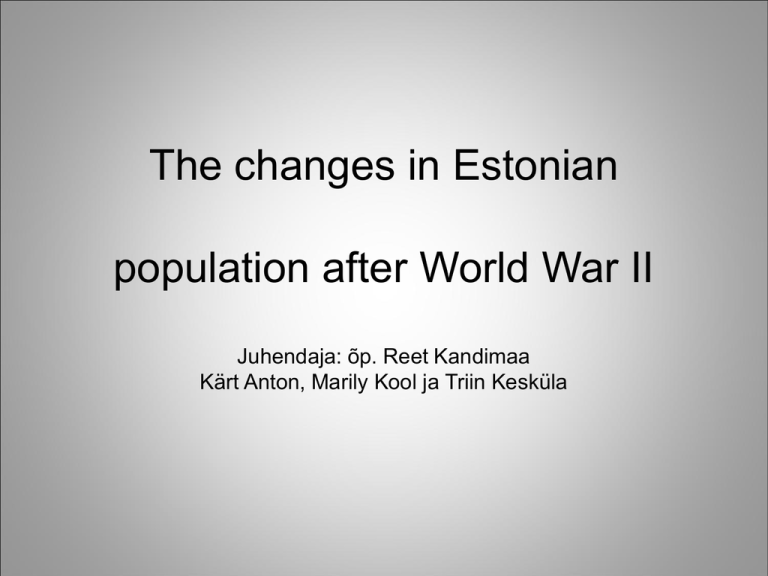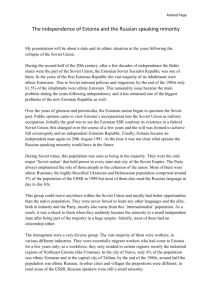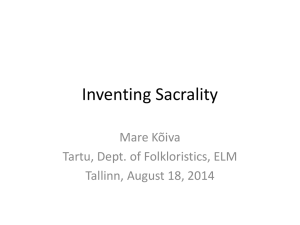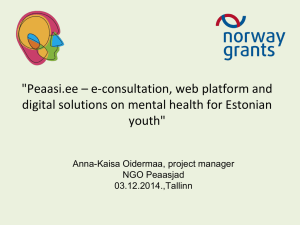Changes in Estonian population after World War II
advertisement

The changes in Estonian population after World War II Juhendaja: õp. Reet Kandimaa Kärt Anton, Marily Kool ja Triin Kesküla Introduction The flight of Estonians to the West during World War II Deportation of Estonians into Siberia in 1949 Immigration of Russians into Estonia during 50 years of the Soviet Era • Estonia was one of the smallest states in Europe in the 1920s and 1930s. • Estonian population was about 1 million people. • During and after WW II Estonia lost about of 150,000 people: people lost in war, war refugees, deportees. Estonia before World War II An Estonian housewife A typical home of an Estonian family Boys behind Aruküla manor A beautiful summer day Our wrestler – Olympic gold medallist Kalevipoeg – our national epic University of Tartu Theatre Vanemuine The change of power in Estonia 1918-1940 1940 1941-1944 Estonian Republic Soviet occupation Nazy occupation 1944 – 1991 Soviet occupation 1991 Estonian Republic Loss of independence In 1940 Estonia was occupied by the Soviet Union as a result of the deal between Nazy Germany and the Soviet Union (Molotov-Ribbentrop Pact) http://www.youtube.com/watch?v=FsGVOdFAIxw http://www.estonica.org/media/files/images/64/642333028638-29_punaarmee-sissemarss_1939_farh_jpg_690x518_q100.jpg The first mass deportation in 1941 • In June 1941 over 10,000 people from Estonia were arrested and deported to the prison camps in Russia, Siberia • Similar things happened in Latvia, Lithuania, Belarus, Ukraine and Moldova • The Soviet Union wanted to ruin the independent statehood and suppress the people with fear and terror • Politicians, the military, scientists, the clergy, businessmen and their families were the victims of deportation The victims of deportation in 1941 Prime minister Otto [August] Strandman shot himself when he was arrested Prime minister Friedrich Akel was murdered on 3 July 1941 in Tallinn Prime minister Jaan Teemant was arrested on 27 July1940 by the Soviet Union, died in prison Nazy Germany occupies Estonia •On June 22 1941 Nazy Germany declared war to the Soviet Union and invaded it. •By the end of August 1941 Estonia was under the German occupation which lasted for about 3 years. http://commons.wikimedia.org/wiki/File:Bundesarchiv_Bild_183-B08041,_Reval,_Besuch_General_Georg_v._K%C3%BCchler_in.jpg?uselang=et http://commons.wikimedia.org/wiki/File:Bundesarchiv_Bild_101I-010-0938-19,_Estland,_Angetretene_Soldaten.jpg?uselang=et Nazy Germany occupies Estonia The second Soviet occupation At the beginning of 1944 the Soviet Army was again at the borders of Estonia. The battles for Estonia lasted for about 6 months. The main cities were seriously damaged, the city of Narva was almost in ruins. http://f5.pmo.ee/f/2010/11/04/460252t20h6b5e.jpg Narva in ruins http://files.ene.test.finestmedia.ee/EV%2090/large/Purustatud%20Narva%201944_164.jpg Theatre Vanemuine before and after the war http://www.ra.ee/fotis/index.php?type=2&id=611770 http://files.ene.test.finestmedia.ee/Varia_ajalugu/large/Tartu_Vanemuine_%20u%201916.jpg Tartu stonebridge before and after the war http://www.tartu.ee/data/kivisild1.jpg Damaged Tallinn http://www.rindeleht.ee/foorum/phpBB2/download/file.php?id=4138&mode=view Damaged Tallinn Theatre Estonia before and after the war http://vanadasjad.files.wordpress.com/2012/04/tlm-f-2004.jpg http://www.estonica.org/et/Teises_maailmas%C3%B5jas_h%C3%A4vinud_Eesti_arhitektuurip%C3%A4rand/#/104/7124/13798/13822/14342/14343/14344/18404 The flight of Estonians to the West during World War II • In 1944 about 80,000 Estonians escaped to Sweden and Germany • They escaped because Estonia was occupied by the Soviet Union and they were afraid of arrest and deportation • About 8,000 of 80,000 people died trying to escape because of autumn storms and they used simple fishing boats which were full of people The flight of Estonians to the West http://migrationsmap.net/#/EST/departures Escaping to Sweden • About 25,000 people escaped to Sweden because Sweden was a rich, prosperous and neutral country • Swedish government was ready to help the refugees – hot cocoa and warm, clean clothes were ready Leaving home Waiting for the boat Refugees leave for Gotland http://www.saartehaal.ee/wp-content/uploads/2008/08/4149.jpg Swedish warship saving the refugees Arrival in Gotland Escaping to Germany • About 30,000 people escaped to Germany, because Germany was close and people could use horse carriages and the railway • Estonian soldiers in the German Army left Estonia with the German Army • Refugees were placed in refugee camps where food and shelter were poor because Germany was full of refugees • In 1947 - 1949 people left Germany and went to other countries with better living conditions – the USA, Canada, Australia On the road to Germany http://www.kool.ee/failid/pogenik.jpg After the flight • Estonians had to get used to the new society, find new jobs • People had to learn a new language – Swedish, German or English and do hard physical labour in the forests, factories or fields • Estonians were valued because they worked hard and were well educated • They were homesick because of lack of contacts with their relatives in homeland • It was 30 years after the war that the emigrees could visit their homeland for the first time Laul - “Ma tahaksin kodus olla“ http://www.youtube.com/watch?v=oDwaXL4_rro Estonians in the Estonian House in Sweden An Estonian school in Stockholm “Better to die at the sea as a free person than to die in Siberia as a forced labourer” Memories “The first night at the sea passed peacefully, but in the morning a strong wind had risen, which turned into a storm. In the afternoon, the engine of the ship stopped working. Because of the strong wind we could not use any sails either. Fortunately, a Swedish warship noticed us the next morning and saved us.” “We had been sailing for only a few hours, when the Swedish naval patrol spotted us and lead us to the port on Fejan island. Some people were saved from drowning by the naval ship and we do not know how many refugees died in that September storm. We know that of fourteen boats, which sailed out from Viimsi port, only nine managed to arrive in Sweden.” The second mass deportation in Estonia In 1949 • The second mass deportation in Estonia took place in March 1949. • The deportation happened during one night, at the same time in all Baltic countries. • From Estonia almost 20,000 people were deported to Siberia. • The majority of deportees were rich farmers with their families. • Some people resisted, they escaped with their families to the forests and to other cities. Children in a deportation wagon Transportation Wagons Forest brothers • The men who did not manage to escape to the West and were afraid of deportation, escaped to the forests • They were called Forest Brothers and hunted by the Soviet Security forces. When captured, they were sent to prison camps in Siberia Metsavennalaul http://www.youtube.com/watch?v=oZIcn YcGmJA Life in Siberia Young Ants Laaneots and uncle Elmar http://arhiiv2.postimees.ee:8080/leht/99/03/25/2lk1.jpg http://www.saartehaal.ee/wp-content/uploads/2012/03/13915.jpg Memories “One captured woman poisoned herself at the train station, the woman's body was sent to the hospital.” “The Russian officer was not a cruel man. He was calm and showed what we should take with us. The Russians promised to take all we wanted.” “Two young people tried to escape, but they failed and were shot on the spot.” “My grandmother took the children away from the village when she heard the warning. My grandmother escaped to the forest. The parents of the children, however, were deported to Siberia.” Life after deportation After deportation in 1941 After deportation in 1949 • People returned to their • Almost all men died in home country after being prison camps, few came away for 8 years back • Their property had been destroyed, strangers lived in • Their wives and children ther homes could return to their home • People who moved back to country their home country could not live in big cities anymore • Occupation bans, limited learning opportunities and other various restrictions remained for a long time Influence of deportations • Investigation and commemoration of deportation was banned for 50 years • Deportations destroyed Estonian economic, political and military elite • Small farmsteads were replaced by collective farms • The lives of about 30,000 people were destroyed • People lived in fear, they did not know what would happen next Commemoration of deportees in Tallinn Commemoration of deportees in Tartu The immigration of Russians into Estonia after World War II • From 1945 -1991 about half a million people from Russia and Ukraine migrated to Estonia • Mostly the immigrants were Soviet Army personnel and Russians who began to work in the factories and oil shale mines • State companies and ministries required cheap workforce • Good salary and living space in blocks of flats were used as bait • Some of the immigrants came to Estonia because of marriage or family relations Soviet Army Workers in the Kreenholm factory New residential area for immigrants in Tallinn Lasnamäe Town of immigrants: Sillamäe Conclusion • The Second World War changed Estonian population a great deal • About 8% of Estonians fled to the West, they were isolated from their homeland for decades • After the restoration of Estonian independence a younger generation of Estonian emigrees contributed to the restoration of independence. For example, President Ilves • Many Estonians deported to Siberia returned to homeland after the death of Stalin in 1953 and had to start their life from scratch • Russian immigration led to the Russian-speaking community, who did not speak Estonian and was located mainly in the North-East of Estonia and in Tallinn. • During the restoration of Estonian independence many Russians were against it and part of them returned to Russia and Ukraine. • Nowadays the Estonian Government tries to integrate the Russian-speaking community - about 300,000 people - into the Estonian society The Estonian flag on top of the tower Tall Hermann in Tallinn Tallinn old town Tartu city centre Snail tower in Tartu Jägala waterfall in spring Jägala waterfall in winter Thank you for your attention!







